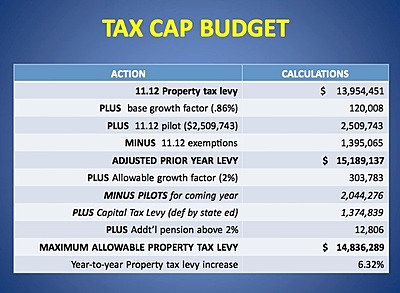- By Dan Veaner
- News
 Print
Print  With a nearly $3 million projected expenditure to revenue gap for the $26,560,000 2012-2013 Lansing school budget, Superintendent Stephen Grimm has been presenting various scenarios for how that could be handled. Monday he presented a new draft of a reductions list that would cut nearly a half million from the new budget, slightly less than half of cuts he proposed at the end of January.
With a nearly $3 million projected expenditure to revenue gap for the $26,560,000 2012-2013 Lansing school budget, Superintendent Stephen Grimm has been presenting various scenarios for how that could be handled. Monday he presented a new draft of a reductions list that would cut nearly a half million from the new budget, slightly less than half of cuts he proposed at the end of January.The cut list started at about $2 million at the beginning of the budget cycle, so this is good news for Lansing programs, or at least better news than it could have been. Last night Grimm said it will prevent having to lose some of the district's best teachers who have a dozen years in the school system.
This plan presented Monday uses an appropriated $1.9 million to reduce the gap to $1,080,500. The cuts account for just under half of that. The result would be a projected tax rate increase of 5.95%. Just over half of that, 3.09%, is caused by the reduction in the value of the AES Cayuga power plant.
Some school board members said they don't want such a high tax rise, despite the fact that half of it is caused by forces outside the school district's control.

"We have to keep in mind that there are a lot of elderly people in this community who don't always come to speak at these forums," said School Board President Anne Drake. "They are on a fixed income. I'm not comfortable sending out a 6% increase for this budget. I have to keep people in mind who have talked to me because they are on a fixed income."
"This is a farming community, too. Farmers are property owners who are already hurting this year," said board member Aziza Benson. "They do OK, but aren't millionaires. They're going to have to absorb that as well."
Last night at a public meeting to get public input on the budget, Grimm and Business Administrator Mary June King said that the numbers had changed because of new state tax cap information. King said that she had submitted the district's cap data to the State earlier yesterday. The new numbers call for $2.1 million in appropriated funds instead of $1.9 to meet the state requirement. That brings the projected tax rate down to 4.48%.
The amended Payment In Lieu Of Taxes (PILOT) agreement between the power plant and Tompkins County gradually decreases the plant’s taxable value from the $112.5 million this year to $60 million in 2014. The decline will decrease the estimated tax paid by the plant from nearly $3.2 million paid in 2011 to approximately $1.7 million in 2014. The lower value of the plant was locked in last week when the Tompkins County Industrial Development Agency voted to accept a renegotiated PILOT agreement.
"Pilots are a big part of that formula," Grimm said. "We're getting crushed by this."
Grimm showed the board a complicated formula that allows the Lansing schools to increase the tax levy by 6.32% to remain in compliance with the new state 2% tax cap law. Even with the reduction in power plant revenue and reduced cuts, the currently proposed levy of $14,419,912 is a bit less than the cap. The maximum allowable tax levy would be $14,836,289 according to the formula. That could be exceeded if a supermajority of voters agree to pay more.
When the first draft of the cut list was shared earlier in the school year, about $2 million in cuts were being considered. Until this week the list was hovering around $1 million. At last Monday's school board meeting the list had been reduced to $469,360 in cuts.
The current proposed cut list includes $1,500 of cuts from the Athletics Department that don't affect the program, $4,000 for an attendance clerk, an $11,000 cut in a partial teaching position for a high school business class, $37,000 for a cleaner, $20,000 for half an elementary school enrichment teacher, $10,000 for a district-wide curriculum coordinator, $30,000 for a director of technology, half of a middle school ELA position for a $27,000 savings, a 0.4 health teacher position at $30,000, a LOTE cut of $38,000, a $30,000 microcomputer specialist, $11,000 in sabbaticals, 0.6 of a middle school science teacher position at $30,000, a $60,000 special education teacher position, $106,390 for a school psychologist, and $9,300 for summer school in the middle school.
Many of the cuts would be accounted for by retiring employees whose positions will not be filled. The total of cuts on the current draft of the list is $469,360. Grimm has stressed that the cut lists he presents are not final decisions, and are changing as new information about the budget becomes available. The actual cuts will be driven by the budget the board finally passes if Lansing voters accept it.
Monday school officials considered ways to explain the budget to the public to help voters understand why the rise is necessary. Grimm presented some ways of looking at the budget that attempt to make it more palatable, including a historical look at school taxes that show an average tax rate rise of only 1.89% over a four year period. He also said that when you combine the 15% town tax rate drop with the proposed school rise the actual increase is only 4.3%.
 Around 30 people filled the Lansing High School library Thursday night for a frank discussion of the school budget, higher taxes, and cuts.
Around 30 people filled the Lansing High School library Thursday night for a frank discussion of the school budget, higher taxes, and cuts.Grimm got a chance to try out that strategy last night when almost 30 people attended a 'town hall' style meeting at the high school library.
He started by explaining the need for a tax rise, outlining how two thirds of the $3 million gap can be coved with 'left over' money, and how the drop in AES Cayuga revenue will amount to 3% more for everyone else. With the half million in cuts he explained that the rise would be 3.4%, slightly more than it would be if the budget vote fails and the stage mandated contingency budget kicked in. The the explained the change in the 'cut list'.
"Cuts in programs would be directly decreasing opportunities for kids," he said. "There is nothing in the cuts that screams 'decreasing opportunities'."
While some argued that greater cuts should be made to insure a sustainable budget for the future, Grimm noted that appropriating $1.9 million each year for the past three years has worked because of careful management that has meant underspending the budget by about that amount each of those three years. He argued cuts shouldn't be made until they need to be and explained that Lansing is in better shape than neighboring school districts because it doesn't rely on as high a percentage of state aid as poorer districts do. As a result dwindling state aid has less impact on Lansing.
People asked about the fate of AES Cayuga, and whether the Town is encouraging business growth to try to make up some or all of the loss. Some residents asked for specific information on how categories of the budget are affected.
But the brunt of the discussion focussed on teacher cuts, salaries, and whether enough is being cut -- or too much. School officials couldn't speak to specifics in the negotiations. There was a clear divide between residents who think the tax burden has reached the breaking point and those who want to give more to support the schools.
Grimm was challenged by some to give up a 4% pay increase to encourage teachers to give up increases as well. That could be significant, because a new teacher contract is currently under negotiation. He and King were asked whether they would do that and they said yes. Various residents said they have talked to individual teachers who are willing to do that, but when Grimm was asked if he and other administrators had offered to take cuts themselves, he replied, "Unions have been approached with that. The answer is no."
"In 2010 the district approached the Teacher's Association regarding making a monetary concession," LFA President Stacie Kropp said Friday morning. "At that point the Association discussed the proposal and did make a concession of $25,000 to the district. They made a similar concession in 2008. Since 2010, the district has not approached the Association and asked for any concessions to be considered."
Administrators were asked what the savings would be to the district if the unions agree to a wage freeze. King estimated it would amount to a total of $450,000 across all three unions.
Board member Aziza Benson pointed out that details of the negotiations can't be discussed in public, and that the old contract that guarantees 3% raises would remain in effect if a new contract can't be negotiated.
Administrators were asked whether efficiency consultants have been used. Board member Glenn Swanson noted that a lot has been done in area of energy efficiency. Grimm said more of that could be done in other areas.
He also reminded people that 40 positions have been cut over the years he has been Superintendent, and efficiencies have been found in other areas of the budget. Most recently the district has seen big savings in transportation costs by making use of route planning software, and in energy expense because of an energy efficiency contract. He argued the district has been doing a good job of managing its money while keeping taxes to an average rise of around 2% since 2008.
A number of taxpayers were concerned about the long term. They worried that if the district keeps reducing budget gaps by appropriating money that eventually the money will run out. But Grimm said that the district has been underspending its budgets for the past three years, and that state officials have encouraged Lansing to continue using appropriated funds and finding new efficiencies.
"This approach -- it is working," he said. "Past performance predicts future performance."
Five school board members were present last night. Board members said they are working hard to listen to all points of view as they zero in on a final budget over the next month or so.
"This input is critical," said board member Tom Robinson.
v8i9



